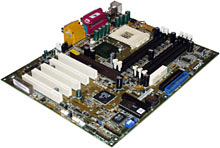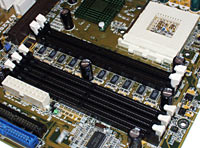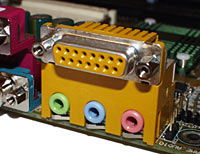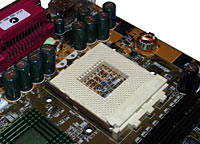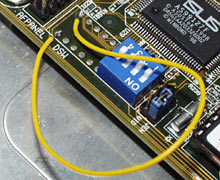
Asus A7A266 motherboard
Review date: 23 March 2001.Last modified 03-Dec-2011.
While Intel and their oddly pigmented henchmen try to persuade the world that nothing as expensive as a Pentium 4 could possibly be a bad buy, AMD have been quietly plugging along with the Athlon and Duron. They're fast, and they're cheap. The Athlon's clearly the best value "power" PC CPU, and the Duron's amazingly cheap, and fast enough that it's not really fair to call it a "value" CPU.
With Double Data Rate (DDR) memory, the AMD chips are even faster. The Alpha-derived EV6 bus the Athlon and Duron use has always doubled the Front Side Bus clock speed for CPU-to-motherboard-chipset communication, but Standard Data Rate (SDR) memory runs only at the FSB speed, and so can bottleneck memory-intensive operations.
As I discovered when I checked out a DDR 1.2GHz Athlon machine last year (review here), more RAM speed really does mean more system performance, provided you've got a lot more RAM speed. PC2100 DDR memory gave a 30 to 40 per cent speed boost for real world tasks, compared with the less-than-half-as-fast PC100 memory that was then the standard for un-tweaked Athlons.
A word on the jargon, here. DDR RAM is named according to its peak bandwidth in megabytes per second; SDR RAM is named according to its clock speed.
If you use the DDR-style big-numbers naming convention for SDR memory, PC100 RAM becomes PC800, and PC133 becomes something like PC1050. PC1600, which runs at 200MHz (100MHz FSB, doubled) only has a 50% bandwidth advantage over PC133; PC2100 runs at 266MHz (133MHz FSB, doubled) and is twice as fast as PC133, as you'd expect.
So DDR is cool. DDR is nice. DDR is tempting.
But DDR RAM is also just too darn expensive.
Full-speed 266MHz PC2100 DDR RAM will set you back more than $AU400 for 128Mb and more than $AU700 for 256Mb. You can get DDR RAM considerably cheaper by going with unknown brands and settling for PC1600, but the off-brand modules often have compatibility problems (you may find you can't use more than one RAM module at a time...) and PC1600 probably won't let you run the RAM fast enough to take advantage of the faster FSB speeds of newer Athlons.
They want 133MHz FSB, PC1600 is specified for a 100MHz FSB, and it's not likely to stretch. Especially if it's suspiciously cheap. $US110 or so per 256Mb PC1600 module is the low water mark as I write this, and that deal smells to me exactly like every other low water marks.
Plain PC133 SDR memory, on the other hand, just keeps getting cheaper. 128Mb for about $AU120, 256Mb for about $AU220. And those are name-brand modules, delivered. A 256Mb PC133 module from one of the same questionable US dealers that do super-cheap DDR RAM will only set you back $US45 or so.
I have no information on whether you have to solder the chips on yourself, for that price.
For the price of 256Mb of quality PC2100 DDR, you can get 832Mb of quality PC133. Or. more realistically, you can get 320Mb or 512Mb, which is all you need for practically any home or office computer, and also get a hefty chunk of change.
DDR memory isn't going to stay painfully expensive, though. Soon enough, it'll be cheap enough that it'll be well worth buying, to get the substantial speed boost the big slug of extra RAM bandwidth brings with it.
What if you have to upgrade now, though? Do you bite the bullet and spend big bucks on DDR, or do you settle for a boring SDR machine? DDR and SDR RAM use different slots and need different motherboard hardware; you can't just take an old Athlon and drop DDR memory into it any time, and you won't ever be able to upgrade a new motherboard with DDR memory unless it's got slots to take it.
So, if you've got to upgrade now, what you want is a motherboard that can take both kinds of memory.
And here one is.
Both kinds of music
Voila, the Asus A7A266. With three SDR slots and two DDR slots, it uses ALI's annoyingly named ALiMAGiK 1 chipset and lets you install cheap SDR RAM now, and upgrade to expensive DDR RAM later. Problem solved.
In case you're wondering, you can't mix memory; it's SDR or DDR, not both at once.
And with only two DDR slots, the A7A can't take a ton of DDR memory unless you use high-capacity modules. But a couple of 256Mb modules will do most people, and larger ones will become commonly available soon enough.
Most people who make use of three or more memory slots do so because they're recycling smaller modules from another computer. You might as well make use of that old 64 or 32Mb module, if you've got a slot to put it in. When you're buying all new RAM, it's generally cheaper to buy fewer, larger modules, so having only two slots isn't a serious handicap.
That's just as well, actually; quite a few current DDR-only Socket A motherboards only have two memory slots.
Other features
The A7A266 isn't an especially remarkable Socket A motherboard, if you don't care about its dual memory capability.
It's got on-board sound, using a C-Media chipset which is better than the usual AC97-compliant audio, but which still won't be very interesting to anybody who wants 5.1 channel digital THX everything. You can disable the on-board sound and install whatever sound card you like, of course.
My review board had a defect - the right sound channel didn't work. It seemed to be just an electrical problem - a dud socket, perhaps, or a cracked trace on the motherboard - and it's not something I've heard anybody else report. But this is exactly the sort of thing you don't notice until you've finished assembling your PC, and swapping out a motherboard with a glitch like this is a pain.
There are various other seldom-used extras on the A7A. As well as its industry-standard one AGP slot and five PCI slots, it's got an Audio Modem Riser (AMR) slot for cheap host-based modems and sound cards which only really interest system integrators.
The AGP slot's the extended AGP Pro type, which is unnecessary for most buyers, because as far as I know there are no consumer AGP Pro cards. The extra contacts in the Pro slot allow cards that need as much as 110 watts of power to work (against the 25 watts that normal AGP can supply), but only pro graphics workstation boards actually need this much power. No harm done, though; normal AGP cards work fine in a Pro slot.
There are two connectors for extra USB ports, each of which lets you add two more back-panel USB ports to the two already mounted on the motherboard. You get one two-port card and cable with the motherboard.
There are Wake On LAN and Wake On Ring connectors, which let the computer power up in response to a power-on command from the network, or an incoming call, if you've got a compatible network adapter or internal modem installed.
And there's the usual complement of internal input connectors so you can connect other gadgets' sound output to the built in sound hardware - CD audio, modem, Aux and internal microphone.
There's also a connector for Asus' "iPanel", an optional display that sits in a 5.25 inch bay front panel slot and lets you see power-up errors, CPU speed, FSB speed, fan speed and temperature readings. And which also gives you a couple of front-panel USB ports.
Confusingly, there are two places you can plug in an IDE activity LED, both documented in the manual, but only one of them seems to work. You want the two separate pins at the end of the main case connector header block, not the "IDE LED" pins within that block.
Like many current Socket A boards, the A7A's got three three-pin fan connectors (labelled CPU, PSU and Case, but you can use them for anything you like), and a temperature sensor in the middle of the CPU socket, where it can get a half-decent idea of how hot the processor is. This is handy, when you're...
Overclocking
Physically, the A7A looks well suited for use by the lunatic fringe. The CPU socket doesn't have any filter capacitors hard up against it, so pretty much any cooler, no matter how preposterous, ought to fit.
Unfortunately, with its standard BIOS, this board can't do CPU multiplier adjustment from the BIOS setup program. The CPU multiplier determines the core speed - FSB times multiplier equals CPU speed.
The A7A's got some DIP switches that let you set the FSB speed, but you can do that more flexibly in the BIOS. There's a space on the board next to the FSB switches that may have multiplier switches when some future revision of the board comes out.
That's what happened with Asus' earlier A7V, one of the first overclock-friendly Socket A motherboards. I reviewed the original A7V here and the one with more switches here.
Until that updated A7A comes along though, we either have to wait for a BIOS update with multiplier adjustment, or just do without.
(Update: You can do proper overclocking with the A7A266 now, but it's not quite plain sailing. Click here for my how-to guide.)
The lack of multiplier adjustment isn't as important as it used to be, though. Most Socket A CPUs are multiplier locked, anyway; you need to reconnect some bridges on the top of the chip to make multiplier adjustment possible at all, as I explain in my earlier motherboard review here. It's easy enough to do (all you need is a pencil!), but a lot of people don't want to fool with their CPU.
Fortunately, the CPU doesn't care whether it's running at, say, 8 X 100MHz, or 6 X 133MHz. Both add up to an 800MHz core speed, and that's all that matters. As long as your motherboard can handle the FSB you want, you're fine; anything you can do with a higher multiplier, you can also do with a higher FSB.
Older Athlon motherboards of various flavours weren't much good for FSB overclocking. Early ones had a hard time getting the standard 100MHz FSB up to even 110MHz reliably, and 120MHz was the practical ceiling for many others. Without multiplier adjustment - which, on old Slot A boards, is done with little plug-in gizmoes on the processor like the one you can see in my older piece here - it was hard to get a decent amount more speed out of the CPU.
But the A7A, like other boards made for the new 133MHz FSB Athlons, can of course handle 133MHz without any trouble at all.
So this is how you get a decent overclock out of a 133MHz-FSB-capable motherboard like the A7A, without fooling with the multiplier.
First, you buy a 100MHz FSB Athlon or Duron, not one of the new 133MHz FSB ones.
850MHz 100MHz FSB Athlons are under $AU300 now, delivered, and you'll pay less than $AU140 (!) for a 650MHz Duron, which is the equal of a 600MHz Athlon any day.
Next, you buy PC133 SDR memory, or PC2100 DDR memory, if you're feeling wealthy.
Now, you put it all together, and you wind up the FSB, safe in the knowledge that if anything holds you back from at least a 33%, 133MHz FSB overclock, it's the CPU core, not the motherboard or RAM.
The A7A is meant to give you 1MHz FSB increments, but the initial release BIOS doesn't do it. You instead get an odd selection of 23 possible settings, each of which is a linked FSB, RAM and PCI bus speed set. Overclocking the PCI bus significantly from its default 33MHz isn't a good idea. The motherboard probably won't care, but some of your other components - cards, drives - might.
The available settings go from the drastically underclocked 66/66/33, through the default-for-100MHz-FSB-CPUs 100/133/33 and default-for-133MHz-FSB-CPUs 133/133/33, to the rather improbable 147/147/37.
If you start out with a 100MHz FSB CPU, there are only a few good options. 110/110/37 will very probably work fine, and 120/120/30 probably will too. Both run the RAM a bit slower than the default setting, but SDR RAM speeds (or pre-doubling DDR RAM speeds) faster than the FSB speed give no real world speed increase to speak of, and the 110-to-133MHz difference is only a 21% one, anyway.
Since a 2.66-fold increase in RAM speed (from PC100 to PC2100) only gives you maybe a 35% performance difference for tasks that care about RAM speed, the maximum speed loss you could conceivably suffer from the 133-to-110MHz RAM underclock, ignoring the bottleneck effect of the FSB, would be less than 5%.
Taking the beneficial effect of raising the CPU speed into account, plus the FSB bottleneck, as long as the RAM speed's at least equal to the FSB, it's fine.
The A7A266 also lets you fiddle with the CPU core voltage, in 0.025 volt increments. Higher voltage settings can let you get a balky processor to run stably at a higher speed, as long as you've got enough cooling to deal with the extra heat created.
I used a 1.75V 1GHz Athlon on the A7A266, and it allowed me to set the voltage up to 1.85V, which is about as high as you want to go without a very serious cooling system.
If you're goosing up the FSB on an A7A, it's more sensible than usual to be careful about it, and to back off when your operating system starts to have doubts about loading.
If you over-overclock and paint yourself into a corner, ending up with a computer that can't perform its Power On Self-Test (POST), you're meant to be able to set the BIOS back to default settings by powering up with the Delete key held down.
If that doesn't work - or if you set a BIOS password and then forget what it is - the normal strategy is to unplug the computer and use a jumper on the motherboard to clear the CMOS memory and set everything back to defaults.
But the A7A doesn't have such a jumper.
It's got a couple of little solder pads next to the backup button cell, which you have to short with a screwdriver or something.
It's rather fiddly.
Overall
If you don't want to overclock but do want a combo SDR/DDR Socket A motherboard, the A7A266 is a great buy right now. The built in sound (which I presume normally has two working channels...) compensates somewhat for the higher than usual price. It's a solidly made, well documented, full-featured board.
If you're happy to buy DDR memory along with your new motherboard, though, there's no point spending more money to get a board with only two DDR slots and three SDR slots you're not going to use.
And if you're a rabid overclocker, hang around for the version with more DIP switches and/or full Wring-That-CPU's-Neck features in the BIOS.
Personally, I'm quite happy with the A7A. I'm using it in my main computer, on which I'm writing this review, and I'll probably hang onto it for a while.
It's not the perfect motherboard, but it's good, and it'll probably be better soon.
